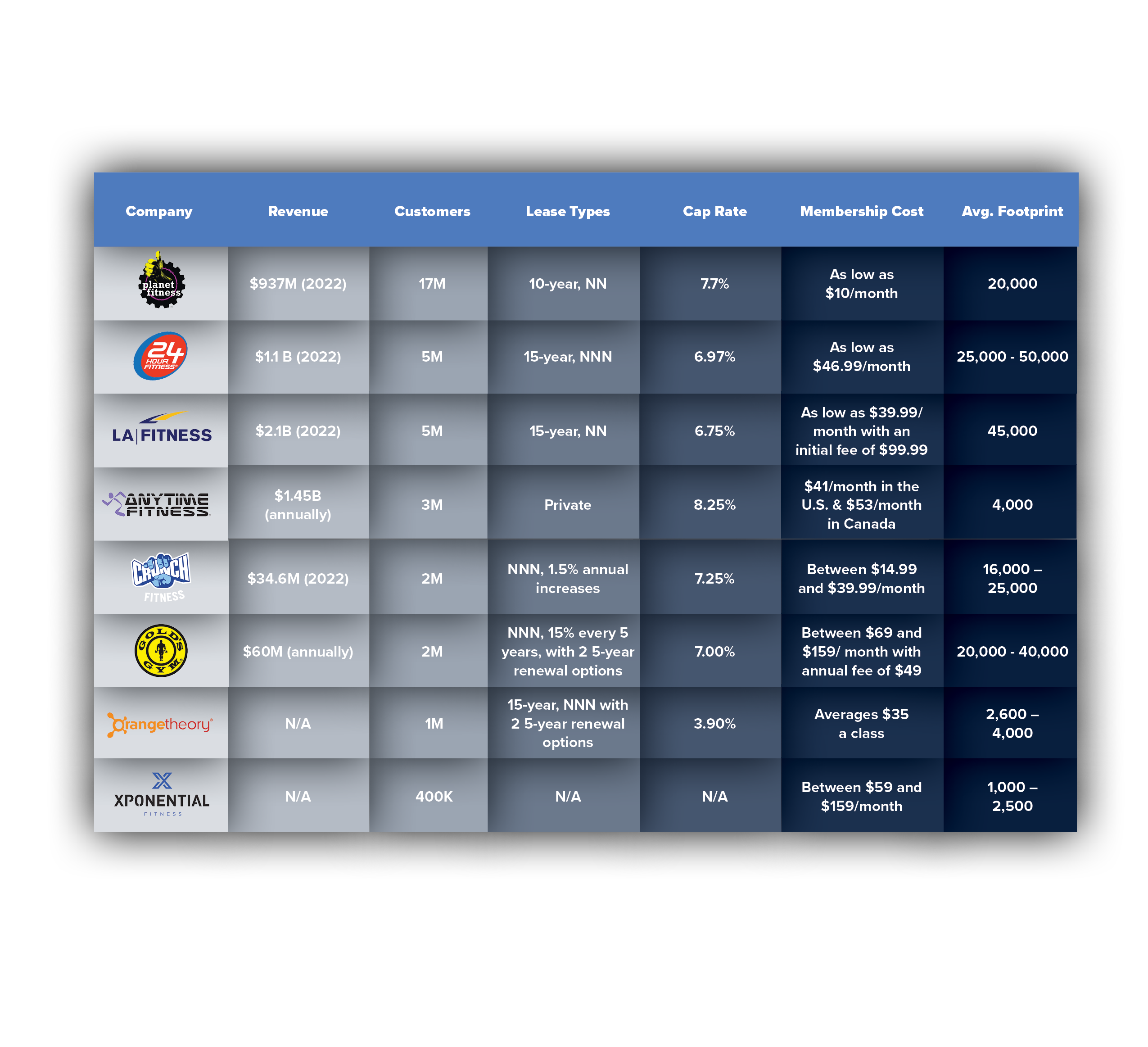How Have Gyms Adapted Their Real Estate?
Assets in the fitness industry are continuing to grow investor demand within the net lease retail space. Although most big-box gyms and other fitness facilities faced temporary closures during the pandemic, they have been quick to rebound as consumers realize the importance physical activity plays in lifestyle. For example, in May 2021, when COVID-19 capacity restrictions were lifted, gym traffic returned to 83 percent of pre-pandemic levels. That consumer demand has driven investors’ interest, according to B+E, transactions year-to-date have more than doubled compared to 2020 and sales prices increased by approximately 180 percent. Looking ahead, the trajectory of gyms reflects that of the physical office in many ways. For example, advances in technology have made in-home fitness a convenient way to get a sweat in, but others may crave human interaction and equipment they can’t find at home. But, instead of viewing this new routine as a threat, many gyms have leveraged the at-home workout lifestyle to their benefit.
The Only Bad Workout, Is No Workout
With more fitness options than ever before, people can exercise at big-box gyms, sports clubs, and smaller boutique fitness studios, as well as through on-demand at-home digital platforms. No matter the type of platform or approach to fitness, the industry is booming, and there are plentiful opportunities for investors and owners.
Brick and mortar fitness-related retail might just be here to stay. Physical locations are finding more and more customers favoring the in-person experience and using online platforms as a supplementary service. Most data related to in-home fitness has proven that they can stick around and co-exist with physical gyms. This current state of the market also gives light to the future of fitness centers. Numerous technological developments, research, and societal trends have shifted consumer preferences toward more personalized or boutique experiences, such as pilates, yoga, dance cardio, boxing, HIIT, and functional training.
27% of regular exercisers describe themselves as “absolute beginners.” Although 81% of beginners are interested in group activities, 66% prefer to exercise alone.

Competition Breeds Excellence
With so many options in the market today, many investors and owners are concerned with the market becoming saturated and these boutique brands over-shadowing big-box gyms. After a decade of intense growth and constant shifting trends, this competition has become a breeding ground for new formats and reinforcement of healthy habits. Plenty of investors are still bullish on the category. The one-size-fits-all approach to big-box gyms is evolving as consumer needs change, and brands begin incorporating personalized, boutique experiences.
Concepts that have gained steam over recent years are gym or class passes that offer unlimited access to various clubs, gyms, or studios under one membership. An example of this is Gym Pass, which provides a solution for corporate wellness and recently partnered with LA Fitness to allow more people opportunities to get fit.
Cost is an important factor for many consumers. Oftentimes, consumers cannot pay $180 per month for access to boutique gyms when compared to paying as little as $10 per month at big-box gyms. Especially with inflation running rampant and economic uncertainty at an all-time high, consumers are becoming more mindful of where they spend their dollars.
The Fed has made its eighth interest rate increase in a year and hinted that two more are possible to come. This is showing a direct effect on cap rates, causing many investors to reconsider their long-term plans. The cap rates for LA Fitness and 24-Hour Fitness are both NNN with corporate-backed leases, whereas Planet Fitness are double net leases (NN) with franchisee backings.
Health and Wellness Real Estate Continue to Grow
Since the pandemic, consumers returning to fitness looked for more than a workout but a human connection. This prompted rising interest in wellness and associated technology, creating a shift for top fitness brands to implement technologically driven services, personalized recovery/one-on-one training, as well as other health products, including heart rate monitor apps, sleep trackers, and fitness watches.
“The digitization, the technology advancements, how the workout routines can be delivered, and how coaching can be provided—that’s a game-changer a lot of people are replacing machines because they want the newest and greatest technology that comes with that machine. That’s different than what we saw five years ago.”- CEO and Co-Founder of Coltaala Holdings.
Many gyms and studios continue to find ways to enter the market as consumers invest more in their home fitness space. Currently, wellness real estate is expected to rebound, with the hybrid brick-and-mortar and digital fitness segment anticipated to grow from &738 billion in 2020 to $1.2 trillion in 2025, according to the Global Wellness Institute (GWI).
Will the Good Times Last for Fitness Club Real Estate?
Unlike major fitness chains like LA Fitness, which were hit the hardest during 2020-2021 (revenue declined 32.45 percent in 2020), online fitness and smaller boutique studios offering new business models have created the social aspect everyone was missing during the pandemic. Players like Xponential are spearheading this fitness segment of the wellness industry, and in Q4 2022, reported a 44 percent year-over-year increase in revenue to $71.3 million and a 58 percent increase in full-year revenue to $245 million.
Since its foundation, Xponential has become the top curator of boutique fitness brands worldwide, with options spanning pilates, yoga, indoor cycling, barre, stretching, rowing, dancing, boxing, functional training, and running. In addition to its 2,100-plus existing locations, 4,400-plus licenses have been sold, and the company’s brands can be found in 48 states and 12 countries.
How Big-Box Gyms Can Adapt
- Downsize location to cater to neighbor and lifestyle audience
- Hybrid big-box gym experience with at-home classes and group workouts via Class Pass
- LA Fitness & 24-Hour Fitness can downsize their big-box utilization, cut rents, and model themselves after franchisee operators, Orange Theory, Anytime Fitness, and Pure Barre, catering specifically to customer audience
Future Outlook
Since 2009, membership and the total number of club-goers have increased by 26.5 percent, indicating America is continuing to become a more health-conscious nation. With COVID-19 dramatically accelerating the role of physical and mental health, the wellness and gym real estate market was the number one growth leader before and during the pandemic. In addition, gyms are what investors deem “internet-resistant” as their business model can withstand the dominance of Amazon and other major online retailers. Owning service-oriented retail properties has become more important to both institutional and individual investors as online shopping continues to grow at a staggering pace. Nonetheless, the once blighted health club sector is finally getting its chance to shine.









